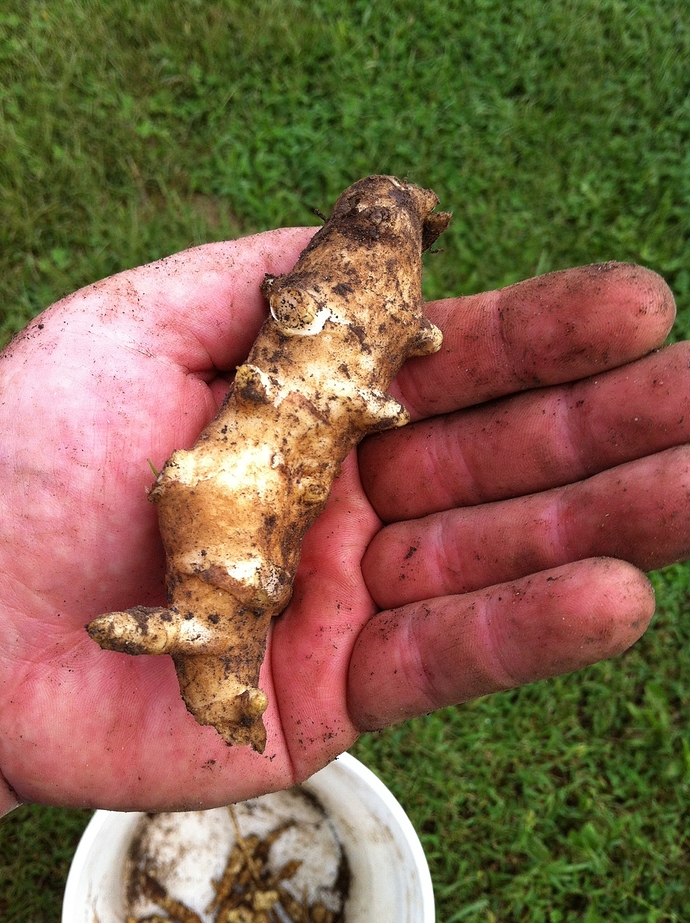Now that the fruit harvest is nearly done I can start harvesting some of my perennial vegetables such as jerusalem artichoke aka sunchoke. Jerusalem artichoke are a delicious member of the sunflower family. They taste like Irish potatoes! We don’t have diabetes but people with diabetes according to many experts can eat these with no ill affects. Sunflowers grow great in Kansas which is why native sunflowers are our state flower.
Clark,
Do you eat them fresh in salads or cook them?
Tony
How do know when they are ready to harvest?
We started calling them “fartichokes” after the few times I tried cooking with them. Jerusalem artichokes did not agree with my families digestion.
Tony,
I cook them like a baked potato.
Anne,
Like a potato a lot of it is based on size. Fall is the best time.
Bigdoug,
You don’t want to eat to many like beans or onions some foods will do it to you. We noticed that about 15 years ago when we first started growing them! We over did and ate a big pan of them because they are so delicious!
At times they can be a little gassy! In small quantities they are Great! They are making wine on another thread.
@clarkinks , if you don’t mind, I continue your thread. I don’t want to create another thread with same topics which will make more entries (and waste time) when searching the key words through the threads.
I just dug up more last year’s Jerusalem artichoke (I still have some stored over the winter in garage). It multiples too fast. I must dig some roots up before they start to grow.
Now my challenge is how do I use these roots? I made wine out of them; I sauteed them; I baked them; Most often, I ues them raw, thinly slice them, add seasoning and herbs, and make salad.
Now, what else you can make out of these roots. I call for creative recipes to help me utilize these healthy but don’t know what to do roots.
Forgot to mention, I have done pickling it. It was pretty good.
I used to grow those. They are pretty and easy to grow. But they are very invasive and they are deer candy.
I normally pickled them with turmeric. Family at first liked it. Then lost interest in them.
It is such a bear to dig them up in early winter. I grew two season, then dug them all up and got rid of them. They still come up from time to time. But it is not too hard to find them and remove them.
All depends on how you value them…
For anyone who has experience with the invasiveness of Jerusalem artichoke, would you recommend planting it in a meadow setting? I have about 5 acres of meadow that I intend to leave in a semi wild state with only yearly or biyearly mowing.
Are there other ‘weeds’ you’d prefer to see? The tubers get quite small in non-cultivated situations. And if you ever desire to be rid of them…it might be trouble.
Right now mainly native grasses and weeds with a few isolated spots of unwanted problem weeds or invasives. During the growing season I just now a meandering pathway through the middle.
So if I planted some in a corner, how big of a patch can I expect that to become and over what timeframe? Honestly, wouldn’t be the end of the world for me if it spread to take up an acre.
They are not invasive here in Kansas. They don’t grow outside of where the soil is rich and deep. Here in Kansas that is only where I added cow manure. If that meadow has black soil expect them to spread. Here we have some loam on top of clay. It’s not the best soil but with some work it’s good enough.
As others said, it depends on soil conditions. I planted them in my square foot garden and they tried to take over. I removed all shoots for two years and that was the end of them. I planted them in four places in my meadow where there is clay soil and plenty of competition. Two areas they died, one area they survived and haven’t increased, and one area they are thriving and have increased over a few years from a few tubers to an area about 2x2. Not really invasive in these circumstances.
@jaunders1
Mine have spread maybe a~ ft. A year.
Have had an a occasional clump come up farther away , possibly from a ground squirrel / vole stash ?
No, they’re not going to spread but a couple feet per year…unless you cultivate the soil and spread some of them via machinery.












